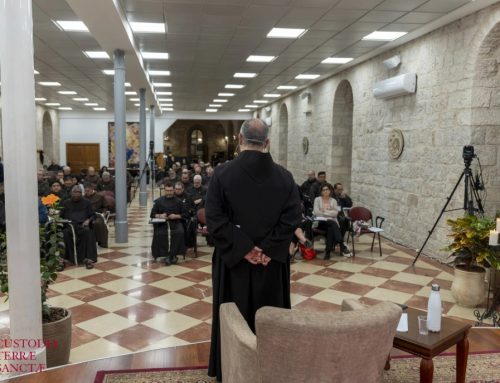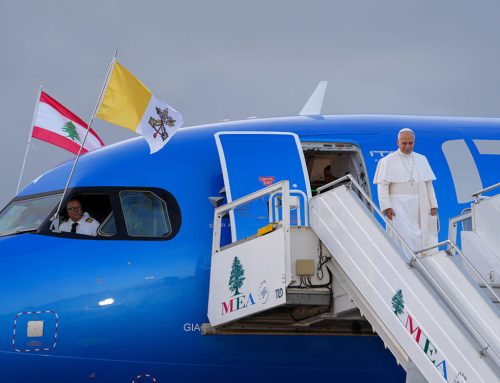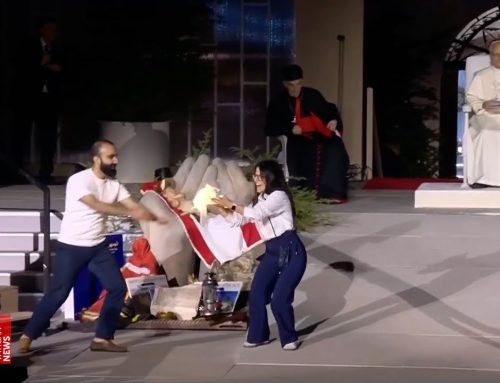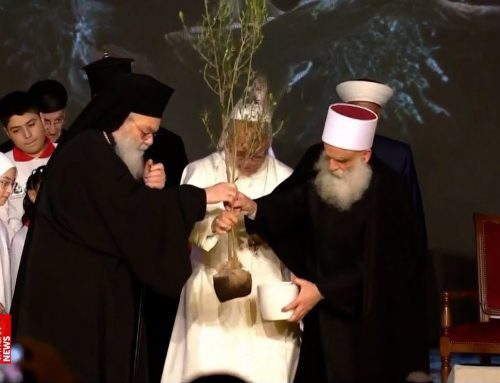The View of Jerusalem Walking through the dramatic gorge of Petra in Jordan, one is impressed by the monumental burial sculptures. They are cut into mountain walls that had been shaped by ancient rushing waters that formed the gorge in the first place.
By Duane A. Burchick, Sr., KHS
The View of Jerusalem
Walking through the dramatic gorge of Petra in Jordan, one is impressed by the monumental burial sculptures. They are cut into mountain walls that had been shaped by ancient rushing waters that formed the gorge in the first place. This is the location that George Lucas choose for Indiana Jones to ride through on horseback to discover the lost Holy Grail. It is a very vaulting natural formation that astonishes all including the ancients. Their aristocracy obviously went to great lengths to take the sting out of death with incredibly costly burial preparations. I wondered at how God had shaped mankind down through the ages to prepare us to accept the meaning of death.
My wife, Lorie, and I were part of a humanitarian delegation representing the Holy Land Christian Ecumenical Foundation (HCEF) that had come to the Holy Land to express solidarity with the Christians in the Holy Land during this time of great trial. There was a siege of Arab communities going on in Palestine, and Jordan was reeling from a severe recession as a consequence. Moreover, many Christians in Jordan had relatives in Palestine and were very worried about developments over there. The delegation was visiting as many of the Christian communities in both Jordan and Palestine to be with them and to listen to them. Against this matrix, my wife and I were also taking our first pilgrimage to the Holy Land.
Moving north we visited the towns of Kerak, Idr, and Madaba where we walked out onto Mount Nebo as John Paul II had when he started his pilgrimage. He had stood on the approximate place where Moses had looked out and saw the Holy Land for the first and last time. It is an awesome view where the heights of Moab steeply drop down to the anvil of the Jordan valley. Across the expanse, filtered by the fine desert dust elevated by the distant Sahara winds, stood the middle mountains of Palestine and the city of Jerusalem. Down below in a near line to Jerusalem lay the tributary of the Jordan on Bethany where Christ had been baptized by John. On these heights of Mount Nebo, Moses had sacrificed a snake to God in an action that prefigured the coming crucifixion of Christ. The land itself vectored one’s soul toward the meaning of the acts of Redemption.
Later at night, we had a dinner meeting with the Christian leaders of Madaba at a restaurant on the heights. After a round of presentations and open discussion, the local Christians took us out on the balcony to look over the Jordan Valley at night. The sky was filled with stars, and the Milky Way was discernable. Over on the western horizon, nestled in the mountains, lay Jerusalem, it’s lights aglow and clearly discernable. Like a beacon, it drew us into the unfolding message of Christ. There is drama here in Jordan as one walks the holy pilgrimage in the footsteps of our spiritual ancestors and progresses towards Jerusalem.
The Crossing
Coming down out of the heights of Moab during the day, we headed toward the Israeli border crossing at the King Abdullah Bridge. I asked Rateb Rabie if I might borrow his cellular telephone to call my son, Duane Jr. This was the last chance I had to call from the Jordanian cell number, and I knew my children would be worried about the conditions in Israel during the Intifada that was reaching a crescendo. I remembered my own trepidations at learning of the travel warnings issued by the U.S. State Department. Americans were told to avoid travel to Israel, Gaza and the West Bank due to life threatening conditions and acts of terrorism. Yet here we were, headed right into the maw of the storm. I had known we would be here, and my wife was holding in her fears, showing a courageous stoic face that the Northern Utes1 are famed for. I knew that we were with the Arabs and were under their protection. I knew the reality of the situation and how the American media distorts it. I knew we would be safe from Arab militarism, but from the Israeli point of view, we would be one of “them”. I had a reasonable fear of biting an Israeli bullet.
I remembered how I was able to overcome my fears. The whole reason why I was helping the native Christians of the Holy Land was that I saw in them the eyes of my suffering Lord. He was being persecuted in them. I had been working for them for six years, and would not turn back now in His time of need. I created the paradigm that I would not run from Him as He lay suspended on the cross. I resolved to not run away as the other men had done on that fateful Friday long ago. I would stand with John as he had, comforting Our Lord’s mother at the foot of the cross.
I looked at my dear wife, wondering how she was handling her fears. In the preparations for the trip in America, she had struggled with her emotions. Now here she was, approaching the check point. On the Arab side, things were relaxed and quite congenial. Our van was not allowed to cross: we had to take an intermediary bus across the controlled access road, and then be processed through Israeli customs. We had been warned not to take any pictures of the border positions or in the Israeli processing area. Thus as we traveled, Lorie demanded that I keep the shades closed for fear that the Israeli border guards would be offended. A prayer or two seemed to be in order. The process is thorough but tough, and the other members of the delegation would re-warn me not to take pictures. Apparently I have this American tourist glow about me with a ready-camera trigger finger. Hours later we were on another bus headed to Jerusalem.
Bethlehem
Again we traveled to be with as many Christian communities as possible in Palestine. We had been taken down into the greater Bethlehem area to see the destruction wrought by Israeli guns on the homes and people. In that process, my wife had been brought to tears for the people who suffered under it all. I was grateful that she could express our feelings of sorrow where we could not. I, on the other hand, had developed a hearty sense of outrage, but surprisingly not of revenge. I simply wanted this horror to stop. Our Lord was preparing me.
The pattern of the HCEF mission was to be received first by the local Christian community, then move onto a prayerful pilgrimage. Thus on a later visit to the Bethlehem area, we went to the Shrine of the Nativity to pray. The spot of the nativity has been overwhelmed by centuries of building to commemorate and protect it. One proceeds down several levels of ancient limestone sanctuaries until one descends a miniature amphitheater-like stairway into the lower chamber of the nativity. There, a low altar forces the pilgrim to fall on one’s knees to approach. This Lorie and I did, but readily found that prostration was more appropriate. As we lay there in prayer holding hands, I imagined the newborn Jesus, and marveled that God would allow himself to be totally unprotected in our midst. The analogy of His vulnerability extended to the living people of the Holy Land and their utter vulnerability to the force of the Israeli occupation. I prayed for His suffering faithful, that Our Lord take pity on them. Yet in the far reaches of my mind, a meaning to the persecution of His Mystical Body began to stir. As yet, I could not put a reason or rhyme to it.
As I meditated, I looked over to my wife who was now sobbing quietly head down on the limestone floor. She had entered a significant religious experience of which I could only be patient and respectful. After a time, she indicated with a squeeze of the hand that she was ready to get up. Later she related that she had felt as though she had finally come home, to her spiritual home, and had felt the immanent presence of Our Lord and His great love for her.
Jerusalem
After Bethlehem, there was Jerusalem itself, the city that God molded to shepherd his people to Himself. The HCEF delegation was received by the Latin Patriarch, His Beatitude Michael Sabbah at the Knight’s Palace of the Equestrian Order of the Holy Sepulchre of Jerusalem. There, Lorie and I were presented as loyal knight and lady and received the pilgrim’s shell. He complimented the delegation as being a model of all denominations working together to help the suffering in Palestine, and that he appreciated our pilgrimage during these times of great trouble. We in turn gave the Patriarch a crystal cross. He commented: “Can you imaging how many crosses I have been given?” Then I answered: “In that case we have another one to give you, the likes of which you have never seen.” Lorie and I got up to retrieve our package, the Patriarch close behind. We pulled out a Chief Joseph Robe, a blanket favored by the American Indians. Rateb had agreed that it would be most appropriate to represent America, and so I had used my contacts to assure its acquisition. I had called out to a cross-roads town in Northern Arizona, Tuba City, where there operated a trading post of the Navaho. I ordered a Pendleton blanket, and they had it shipped special delivery in time for this trip by the HCEF delegation. It featured a dark blue field upon which strong geometric designs were formed with a central cross: one side of the blanket being almost a shadow image of the other side. The Patriarch was grateful and commented that he would indeed hang this on his wall.
That evening, the Patriarch held a reception for the delegation asking all the assembled leaders of the various Christian denominations to use HCEF as a vehicle for ecumenical solidarity. My friend, Michael Zanbil, introduced me to his bishop, the Archbishop Mar Seweios Malki Murad of the Syrian Orthodox. The archbishop is a tall, handsome gentleman with kindly eyes. I felt a holy aura about him, and knew he was favored of God. I heard the words of John Paul in my mind “Et Unim Sint: that we might be one” and expressed my desire to receive communion with them. He granted me the dispensation, and Michael resolved to take us to the Mass of the Ascension that the Archbishop would say in a few days. Later Michael warned me that we must fast from midnight on to be worthy. I told him that I was happy that we should do so, and that I had followed the same ancient tradition in America. We in fact did make it to the site of the Ascension for the mass, but the delegation was pulled away before communion by scheduling imperatives. My wife and I were greatly disappointed, but we now feel very close to the Syrian communities.
Golgotha
A day later, Michael Zanbil and Rula Shubeita told the delegation that they would take us to the Holy Sepulchre for prayers, and that we should leave early in the morning to assure that there would be only a few prayerful faithful at the site. Unfortunately, the delegation spent every evening past midnight talking to local leaders at the Christmas Hotel, and they were very hard to rouse in the morning. Lorie and I, on the other hand, had awakened automatically at 4 AM and were the only ones to show up that day, so off went the four of us for the climax of our pilgrimage. The others went at later hours on subsequent days.
Old Jerusalem has a silent charm at daybreak. Dim light filters down the narrow canopied alleys onto the worn limestone floor below, and speaks of the convergence of history and faiths. It is a pleasant walk through myriad, narrow avenues to the courtyard of the Holy Sepulchre. The entrance is very modest: nothing speaks of great empires or warlords of fame and wealth as it did at Petra, but it remains alive as the focus of human hearts. Respectfully entering within, we immediately saw the slab upon which the brutalized body of Christ had been laid for burial preparation after He had been taken down from the cross mounted on Golgotha… Golgotha – it stood just to the right, rising up in as a dominating prominence.
I let my mind travel in imagination of what it had been like two millennia ago when He was crucified. The rock prominence had stood outside the old walls, with holes bored into the limestone at the summit for ease of inserting crosses for ongoing crucifixions: the Romans being masters of efficiency. Golgotha, so named for its shape resembled a skull, and was an appropriate place for executions. Helena had the prominence covered with a majestic architectural rendering to give it honor. I thought otherwise that the stark reality would have spoken far more of the event that changed the world.
Lorie and I followed Michael and Rula up the stairs that had been built over the rock. We entered the upper chambers with our eyes quickly centering on the altar of the crucifixion. I felt exceptionally respectful of the sanctity of the place, knowing that I had closed the distance in space to that point where the Redemption occurred. Michael beckoned for Lorie and I to approach the altar over the insertion hole in which the cross was placed in raising it high into the erect position. Again Lorie and I had to kneel to approach hand-in-hand. We placed our foreheads on the rim of the hole, and I desired to close the distance in time. I imagined a dark sky above us with angry rolling clouds while in between loomed the cross. It was about here that the imagery became independent. Fearful now, I dared to behold the brutalized body that the cross bore against the moving sky. With surprise, I somehow sensed all evil over all time focusing down upon that precious body. To my horror, my own sins and transgressions against God were in that insidious flow. I had dared to come to stand with John but instead found myself with the Roman soldiers. “Oh my God I am so sorry!” I apologized over and over again at what I had done to Him whose love I experienced even as I felt unworthy to even grovel at the foot of the cross.
After some time, Lorie squeezed my hand for us to get up. We withdrew a small distance to hold each other, but I was still in the imagery standing at that moment in time and space before our crucified Savior. Tears began to flow down my hardened cheeks as we moved to the right side where a Franciscan was conducting the sacrifice of the mass. I felt driven to my knees with a sorrow building in intensity. I could hear myself sobbing aloud now for His affliction, and realized just how dear God was to me. Still the sorrow intensified and I was forced to the floor in the manner of a Muslim at prayer. The grief was seemingly unsustainable. Water droplets formed on the rock tile.
I recovered in time to hear the priest say in Arabic, but translated by my mind: “This is my body which will be given up for you.” The imagery of His body on the cross was superimposed with the host. “This is the cup of my blood, the blood of the new and everlasting covenant. It will be shed for you for the forgiveness of sins.” I was washed in His blood even though completely undeserving. I was overwhelmingly honored.
——————————————-
1 Utes: Native American tribe originally called Utah by the Spanish. Located in the state of Utah in the Western United States. Originally from Colorado, Northern New Mexico, Utah and parts of Nevada, they suffered a series of wars with the Americans and were finally driven back into much smaller areas. The three Northern bands were pushed onto the Uintah-Ouray Reservation in Northwest Utah. There the best lands of the reservation were taken up by settlers in an action that foreshadowed the events in Palestine.





